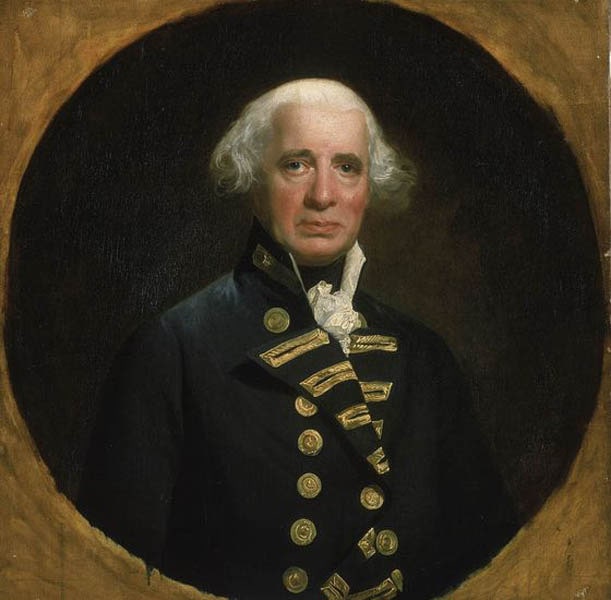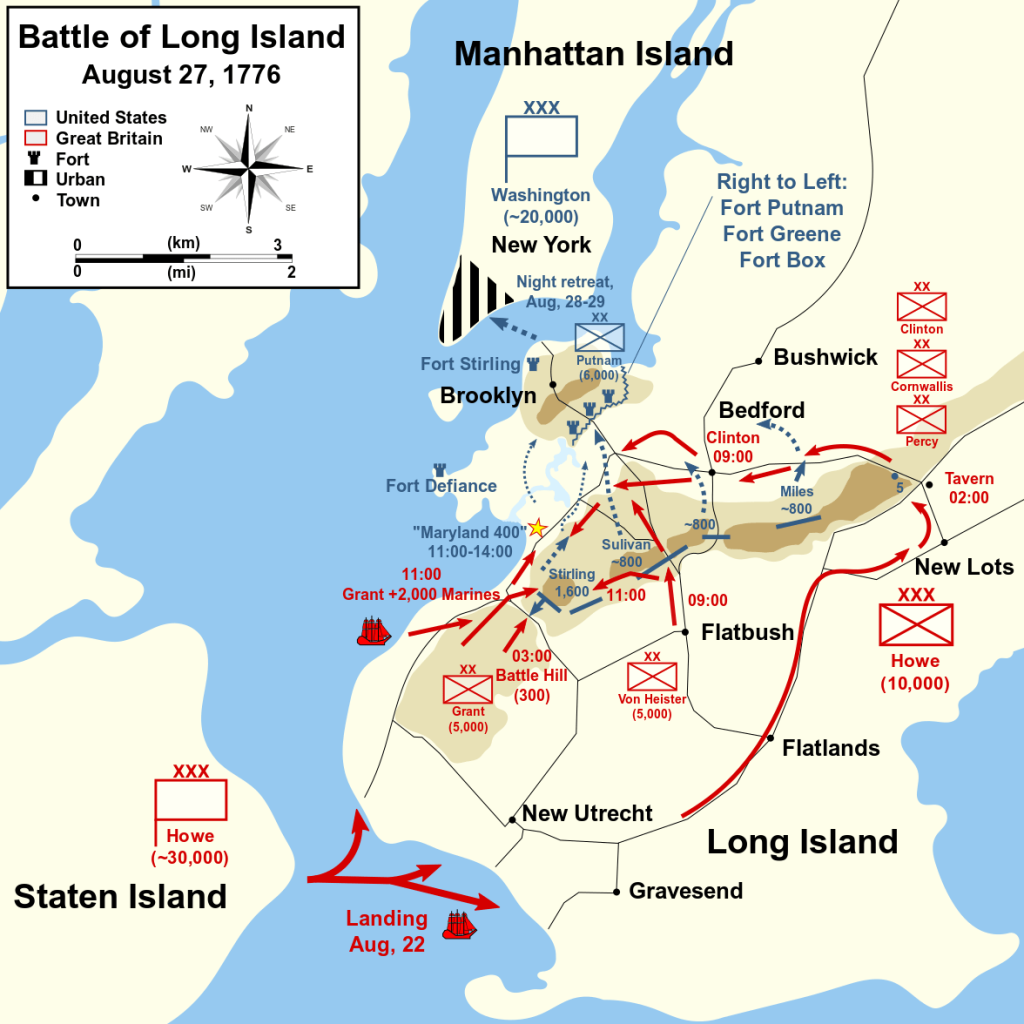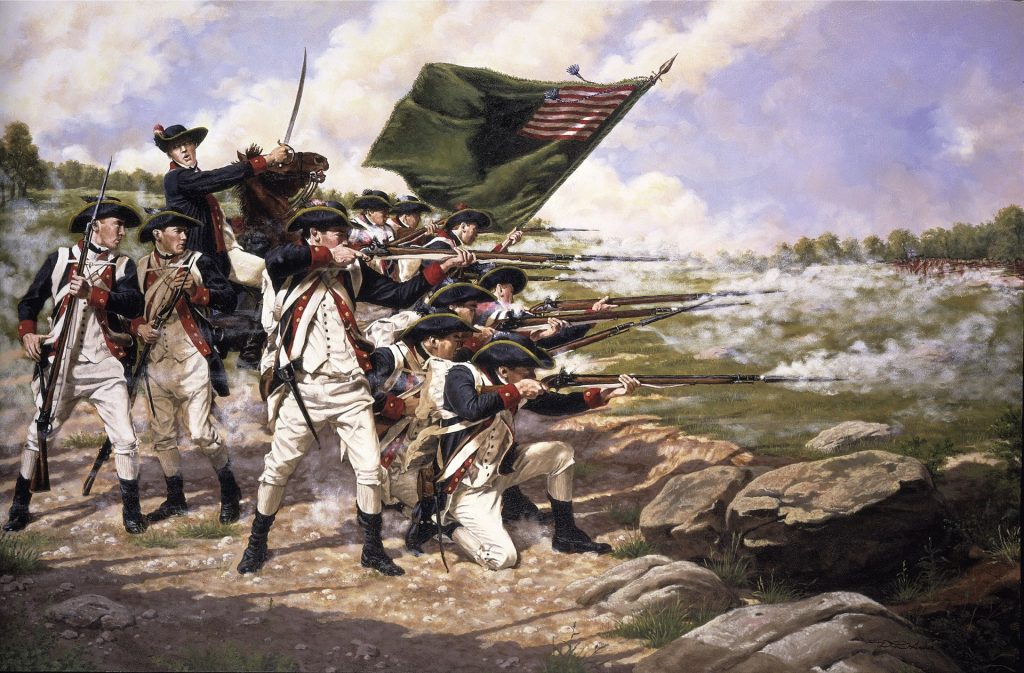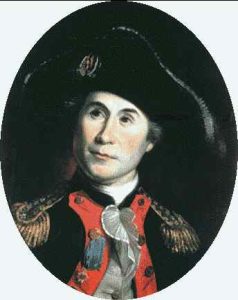Contents
Contents
The Battle of Long Island, also known as the Battle of Brooklyn, was fought between the British and Continental Army on August 27-29, 1776, during the New York and New Jersey Campaign.
Summary
Context
After the Declaration of Independence was signed on July 4, 1776, both sides in the Revolutionary War focused their efforts on capturing the city of New York, which at the time was held by Patriot forces.
The British, under the command of brothers General Sir William Howe and Admiral Lord Richard Howe, knew that New York would make the perfect staging point for the rest of the war.
New York was one of the biggest Atlantic ports in America at the time, acting as a key economic hub in the Thirteen Colonies, with an established maritime and shipbuilding industry.
Holding the city would make it much easier for the British to supply their forces during the war, and the port could act as a springboard for the British Navy as they sailed missions up and down the east coast.
In his position as Commander-in-Chief of the Continental Army, George Washington knew that the British would focus on capturing New York. After defeating the British at the Siege of Boston on March 17, 1776, he moved his troops south and began setting up defenses in the city.
The Americans were led in the field by Major General Israel Putnam. General Nathanael Greene helped set up defenses around Brooklyn but fell ill before the battle began.
Meanwhile, after evacuating Boston, the British retreated to Halifax, Nova Scotia, to regroup and await reinforcements.
Lead up
On June 9, 1776, the British set sail from Nova Scotia, and began to land on Staten Island on July 2.
At the time, Staten Island was unoccupied by the Continental forces, allowing the British to take it unopposed. The area was also inhabited mostly by Loyalists, which helped the British cause.
After landing, the British began to prepare for an attack, slowly gathering reinforcements.
They also attempted to open negotiations with George Washington. The Howe brothers were given the power to issue royal pardons to senior Patriots who ordered their men to stand down.
Though the Declaration of Independence had already been signed, the British believed that they could negotiate an American surrender, especially if they could put enough military pressure on the Continental Army.
Richard Howe sent a letter to George Washington on July 13, offering a pardon if he surrendered. Washington fobbed off the letter as it did not address him properly by rank, before stating that he could not receive a pardon because he had done nothing wrong.

In the meantime, British reinforcements continued to arrive. By August 1, they had approximately 32,000 troops stationed on Staten Island. Of these men, approximately 8,000 were German mercenary units known as Hessians.
By contrast, the Americans had about 10,000 men available on Long Island.
Battle
In the early morning of August 22, British troops began landing at a quiet, unguarded location near Gravesend Bay, on the southwest of Long Island.
Soon, there were 15,000 British troops on the shore, along with a significant number of artillery pieces and guns.

Meanwhile, the Americans had a small forward position, defending three primary access roads in an area known as the Guan Heights: Gowanus Road on the west side, Flatbush Road in the center, and Bedford Pass in the east.
Major General William Alexander (also known as Lord Stirling) was in charge of defending Gowanus Road, while Major General John Sullivan was responsible for the area around Flatbush and Bedford. Approximately 500 men were positioned on each of the three roads.
However, there was a little-known fourth way through the line: the Jamaica Pass, which the Americans barely defended.
The British were told about the Jamaica Pass by local Loyalists, and formed a flanking movement around the right (east) of the American position.
On the night of August 26, 10,000 British troops set out along the Jamaica Pass, while a further 4,000 men were ordered to distract the American front line.
The British plan worked, taking the Americans completely by surprise. In charge of the forward line, Israel Putnam ordered his troops east to meet the bulk of the British force, which left the western side vulnerable to collapse. Soon, the British made it through the American lines, and chaos ensued.

Facing heavy losses, the American forward positions decided to retreat back to the Continental Army’s main position at Brooklyn Heights on August 27. Sullivan and Stirling were taken as prisoners of war, and Washington could only look on in horror.
The British halted their advance and dug in, awaiting reinforcements just outside Brooklyn Heights. This was a controversial decision by Howe – many of his men wanted to immediately press their advantage against the Americans, who were firmly on the back foot.
Washington realized he had to act fast to save his troops, or they risked being decimated at the hands of a much larger British and Hessian force.
On the night of August 29, after a storm disrupted British patrol boats, the Americans were able to sneak away, crossing the East River from Long Island to Manhattan as fast and as quietly as possible.
The operation took longer than expected, but Brooklyn Heights was covered in fog on the morning of the 30th, obscuring the Americans’ movements from the view of British sentries.
Overall, the Americans suffered approximately 300 killed, 800 wounded, and 1,000 captured, many of whom would later die on British prisoner ships. On the other hand, the British suffered 59 killed and 268 wounded, with a further 31 missing.
Significance
Though the Battle of Long Island was a significant defeat for the Americans, their successful retreat did provide a short-term morale boost.
Washington’s escape on the night of August 29 was nothing short of a masterstroke. None of the 9,000 remaining troops were left behind, and according to reports, Washington was the last man to leave Long Island.
The move also frustrated the British, who could not believe that the Patriots had slipped away from them.
However, in its broader context, the Battle of Long Island marked the start of the end of American control of New York City during the Revolutionary War.
The result was celebrated throughout Great Britain, and in September, the British would go on to easily capture Manhattan, before inflicting further defeats on Washington’s men in New York and New Jersey, forcing them to retreat to Pennsylvania.
After the Battle of Long Island, the British held New York for the remainder of the war, using it as an important base for operations up the Hudson and into New Jersey, and also using the city as their main North American headquarters until 1783.
Facts
- The Battle of Long Island was the largest ever fought in America at the time, in terms of the number of troops involved.
- During the battle, Patriot forces chopped down the “Dongan Oak” in an attempt to barricade Battle Pass (Flatbush Road). The site is commemorated today in Prospect Park, NY.
- The maritime operation of the retreat was led by Massachusetts sailor-soldiers under the command of Colonel John Glover, known as the “Marblehead Regiment” (hailing from Marblehead, Massachusetts), or the “Amphibious Regiment.” Together, they successfully shuttled thousands of men, horses, and cannons across the East River in almost complete silence.
- During the British attack, about 260 Marylanders under the command of Major Mordecai Gist made repeated attacks near the present-day Old Stone House in Brooklyn. About 90 to 100 were killed, their sacrifice bringing time for others to withdraw across the Gowanus Creek.


